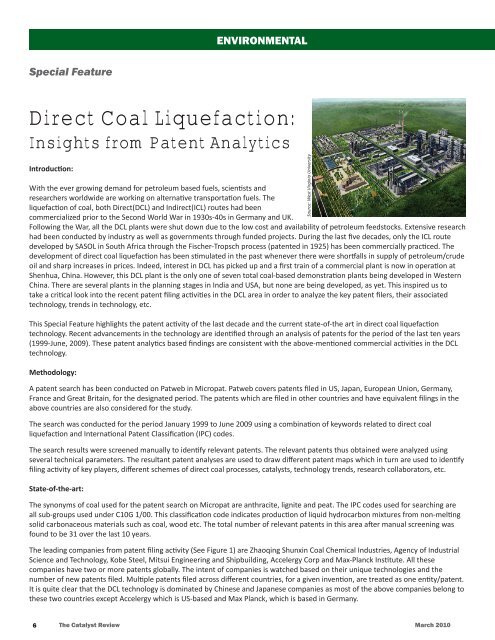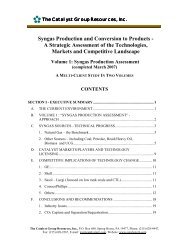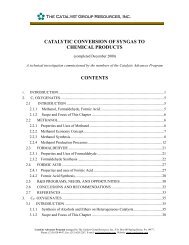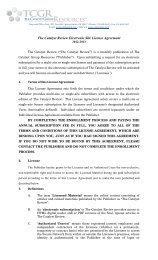THE CATALYST REVIEW - The Catalyst Group
THE CATALYST REVIEW - The Catalyst Group
THE CATALYST REVIEW - The Catalyst Group
Create successful ePaper yourself
Turn your PDF publications into a flip-book with our unique Google optimized e-Paper software.
ENVIRONMENTAL<br />
Special Feature<br />
Direct Coal Liquefaction:<br />
Insights from Patent Analytics<br />
Introduction:<br />
With the ever growing demand for petroleum based fuels, scientists and<br />
researchers worldwide are working on alternative transportation fuels. <strong>The</strong><br />
liquefaction of coal, both Direct(DCL) and Indirect(ICL) routes had been<br />
commercialized prior to the Second World War in 1930s-40s in Germany and UK.<br />
Following the War, all the DCL plants were shut down due to the low cost and availability of petroleum feedstocks. Extensive research<br />
had been conducted by industry as well as governments through funded projects. During the last five decades, only the ICL route<br />
developed by SASOL in South Africa through the Fischer-Tropsch process (patented in 1925) has been commercially practiced. <strong>The</strong><br />
development of direct coal liquefaction has been stimulated in the past whenever there were shortfalls in supply of petroleum/crude<br />
oil and sharp increases in prices. Indeed, interest in DCL has picked up and a first train of a commercial plant is now in operation at<br />
Shenhua, China. However, this DCL plant is the only one of seven total coal-based demonstration plants being developed in Western<br />
China. <strong>The</strong>re are several plants in the planning stages in India and USA, but none are being developed, as yet. This inspired us to<br />
take a critical look into the recent patent filing activities in the DCL area in order to analyze the key patent filers, their associated<br />
technology, trends in technology, etc.<br />
This Special Feature highlights the patent activity of the last decade and the current state-of-the art in direct coal liquefaction<br />
technology. Recent advancements in the technology are identified through an analysis of patents for the period of the last ten years<br />
(1999-June, 2009). <strong>The</strong>se patent analytics based findings are consistent with the above-mentioned commercial activities in the DCL<br />
technology.<br />
Methodology:<br />
A patent search has been conducted on Patweb in Micropat. Patweb covers patents filed in US, Japan, European Union, Germany,<br />
France and Great Britain, for the designated period. <strong>The</strong> patents which are filed in other countries and have equivalent filings in the<br />
above countries are also considered for the study.<br />
<strong>The</strong> search was conducted for the period January 1999 to June 2009 using a combination of keywords related to direct coal<br />
liquefaction and International Patent Classification (IPC) codes.<br />
<strong>The</strong> search results were screened manually to identify relevant patents. <strong>The</strong> relevant patents thus obtained were analyzed using<br />
several technical parameters. <strong>The</strong> resultant patent analyses are used to draw different patent maps which in turn are used to identify<br />
filing activity of key players, different schemes of direct coal processes, catalysts, technology trends, research collaborators, etc.<br />
State-of-the-art:<br />
<strong>The</strong> synonyms of coal used for the patent search on Micropat are anthracite, lignite and peat. <strong>The</strong> IPC codes used for searching are<br />
all sub-groups used under C10G 1/00. This classification code indicates production of liquid hydrocarbon mixtures from non-melting<br />
solid carbonaceous materials such as coal, wood etc. <strong>The</strong> total number of relevant patents in this area after manual screening was<br />
found to be 31 over the last 10 years.<br />
<strong>The</strong> leading companies from patent filing activity (See Figure 1) are Zhaoqing Shunxin Coal Chemical Industries, Agency of Industrial<br />
Science and Technology, Kobe Steel, Mitsui Engineering and Shipbuilding, Accelergy Corp and Max-Planck Institute. All these<br />
companies have two or more patents globally. <strong>The</strong> intent of companies is watched based on their unique technologies and the<br />
number of new patents filed. Multiple patents filed across different countries, for a given invention, are treated as one entity/patent.<br />
It is quite clear that the DCL technology is dominated by Chinese and Japanese companies as most of the above companies belong to<br />
these two countries except Accelergy which is US-based and Max Planck, which is based in Germany.<br />
Source: West Virginia University<br />
6<br />
<strong>The</strong> <strong>Catalyst</strong> Review March 2010






